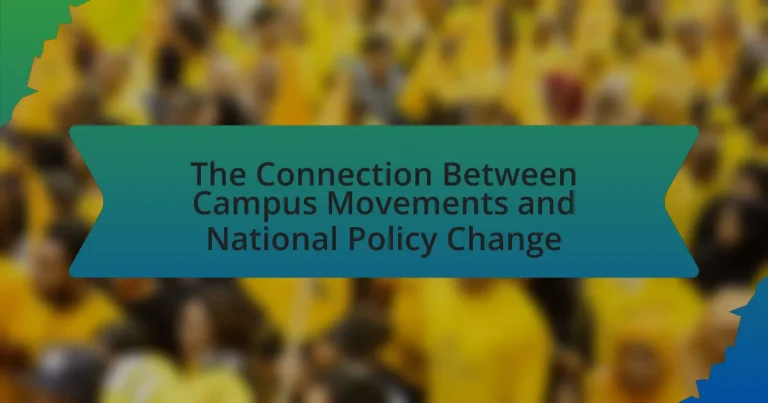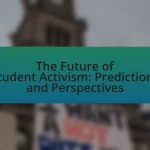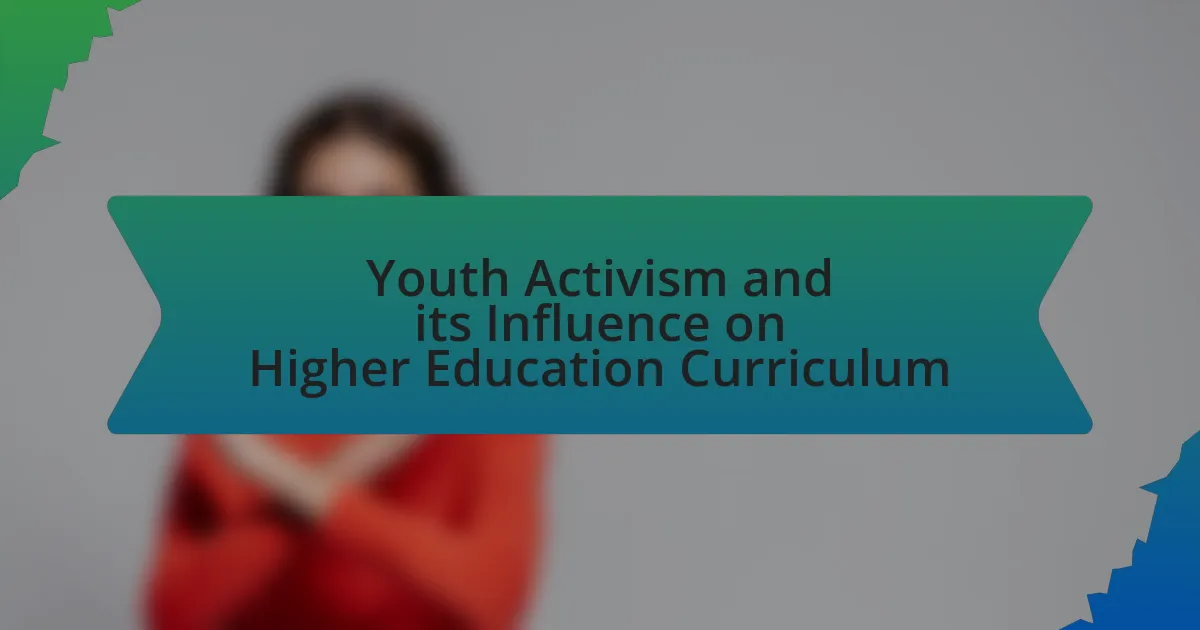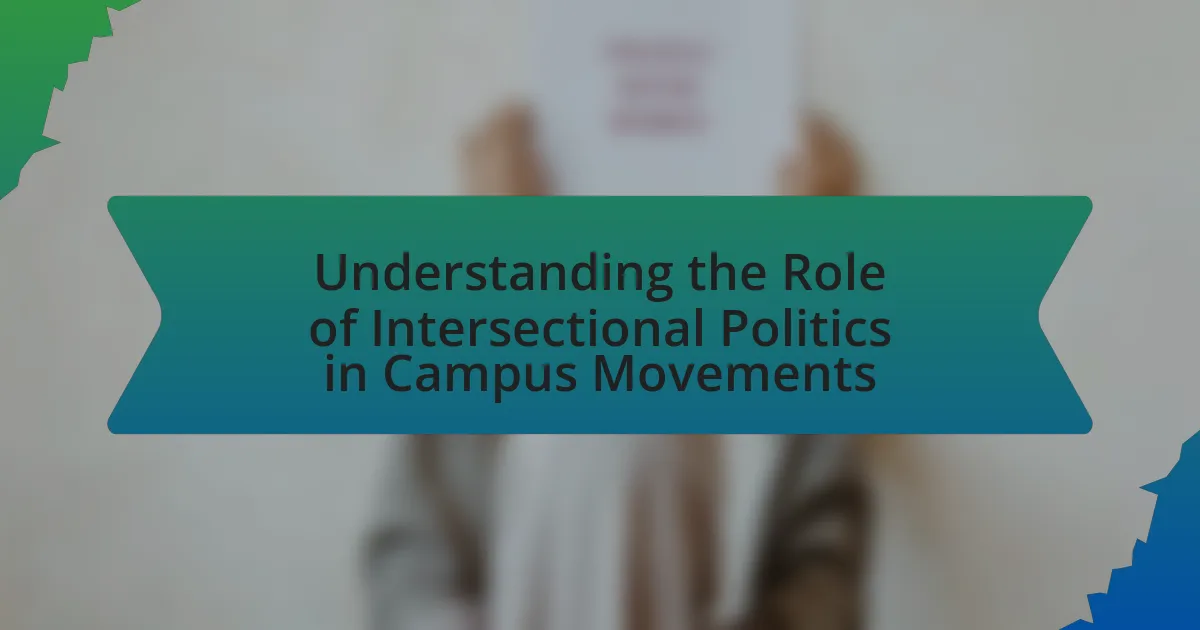The article examines the significant connection between campus movements and national policy change, highlighting how student activism influences public opinion and legislative agendas. It discusses historical examples, such as the Civil Rights Movement and anti-Vietnam War protests, illustrating how campus initiatives can catalyze broader societal discussions and compel policymakers to address pressing issues. The article also explores the role of social media, student demographics, and coalition-building in enhancing the effectiveness of these movements, while addressing the challenges they face in sustaining advocacy efforts and achieving tangible policy outcomes. Additionally, it emphasizes the importance of intersectionality and diverse voices in shaping national policy agendas, ultimately demonstrating how successful campus movements can lead to meaningful legislative change.
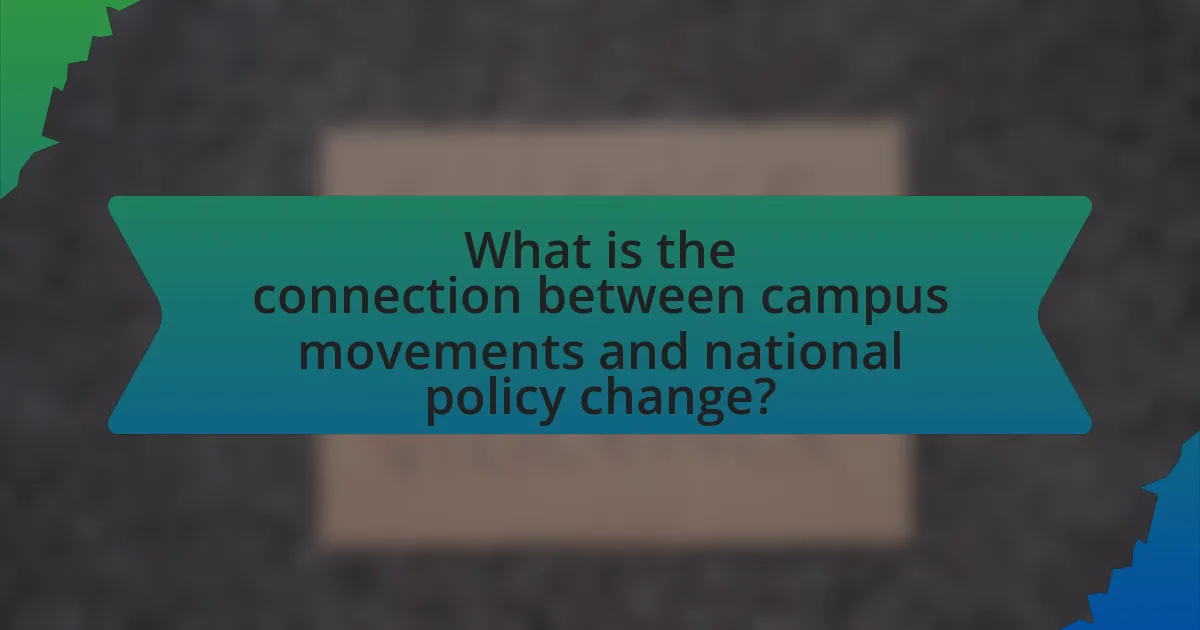
What is the connection between campus movements and national policy change?
Campus movements significantly influence national policy change by mobilizing public opinion, raising awareness about social issues, and pressuring policymakers. For instance, the Civil Rights Movement in the 1960s saw college students actively participating in protests, which contributed to the passage of the Civil Rights Act of 1964. Similarly, the anti-Vietnam War protests on campuses in the late 1960s played a crucial role in shifting public sentiment and ultimately led to changes in U.S. foreign policy. These movements often serve as catalysts for broader societal discussions, compelling legislators to respond to the demands of the younger generation and address pressing issues such as racial equality, climate change, and education reform.
How do campus movements initiate discussions on national policy?
Campus movements initiate discussions on national policy by mobilizing students to advocate for specific issues, thereby influencing public opinion and political agendas. These movements often leverage social media and organized protests to raise awareness, drawing attention to topics such as climate change, racial justice, and educational reform. For instance, the March for Our Lives movement, initiated by students after the Parkland shooting in 2018, successfully brought gun control to the forefront of national discourse, leading to legislative discussions and proposals. This demonstrates how campus activism can translate local concerns into broader national conversations, ultimately impacting policy decisions.
What historical examples illustrate this connection?
Historical examples illustrating the connection between campus movements and national policy change include the Civil Rights Movement and the anti-Vietnam War protests. The Civil Rights Movement, particularly the student-led sit-ins and Freedom Rides in the 1960s, galvanized national attention and led to significant legislative changes, such as the Civil Rights Act of 1964. Similarly, the anti-Vietnam War protests, especially those organized by college students in the late 1960s, influenced public opinion and contributed to the eventual withdrawal of U.S. troops from Vietnam, as reflected in the 1973 Paris Peace Accords. These movements demonstrate how student activism can directly impact national policy decisions.
How do student demographics influence policy discussions?
Student demographics significantly influence policy discussions by shaping the priorities and perspectives that policymakers consider. For instance, a diverse student body can bring attention to issues such as racial equity, gender rights, and socioeconomic disparities, prompting policymakers to address these concerns in their agendas. Research indicates that campuses with higher percentages of underrepresented minorities often see increased advocacy for inclusive policies, as these groups mobilize to voice their specific needs and challenges. This dynamic was evident during the Black Lives Matter movement, where student activism led to national conversations about police reform and social justice, demonstrating how demographic representation can drive policy change at broader levels.
Why are campus movements significant in shaping public opinion?
Campus movements are significant in shaping public opinion because they mobilize young people around social and political issues, often leading to widespread awareness and engagement. These movements serve as incubators for activism, where students articulate their concerns and advocate for change, influencing broader societal narratives. For instance, the Civil Rights Movement in the 1960s saw college students playing a crucial role in protests and sit-ins, which helped shift public perception and policy regarding racial equality. Additionally, contemporary movements like Black Lives Matter and climate activism have gained traction on campuses, demonstrating how student-led initiatives can resonate with the public and prompt discussions that lead to policy changes at national levels.
What role does social media play in amplifying campus movements?
Social media plays a crucial role in amplifying campus movements by providing a platform for rapid communication and mobilization among students. It enables the dissemination of information, allowing movements to gain visibility and attract support beyond the campus community. For instance, the #BlackLivesMatter movement gained significant traction through social media, leading to widespread protests and discussions about racial injustice, which influenced national policy debates. Additionally, studies show that social media engagement can increase participation in campus events, with platforms like Twitter and Instagram facilitating real-time updates and fostering a sense of community among activists.
How do campus movements mobilize community support for policy change?
Campus movements mobilize community support for policy change by leveraging grassroots organizing, raising awareness, and fostering coalitions. These movements often engage students and local residents through events, social media campaigns, and public demonstrations, which create a sense of urgency and collective action around specific issues. For example, the 2018 March for Our Lives, initiated by students from Parkland, Florida, galvanized national attention and community involvement in gun control advocacy, resulting in legislative discussions across various states. This illustrates how campus movements can effectively connect local concerns to broader policy debates, thereby influencing decision-makers and rallying community support for change.
What challenges do campus movements face in influencing national policy?
Campus movements face significant challenges in influencing national policy, primarily due to limited political power and resources. These movements often lack the financial backing and organizational structure that larger political entities possess, making it difficult to sustain long-term advocacy efforts. Additionally, campus movements may struggle with fragmentation, as diverse student groups often have differing priorities and agendas, which can dilute their collective impact. Furthermore, the transient nature of student populations means that leadership and momentum can be lost as students graduate, hindering continuity in advocacy efforts. Historical examples, such as the anti-Vietnam War protests in the 1960s, illustrate that while campus movements can raise awareness, translating that into concrete policy change often requires sustained engagement with policymakers, which is challenging given these obstacles.
How do institutional responses impact the effectiveness of campus movements?
Institutional responses significantly impact the effectiveness of campus movements by either facilitating or hindering their goals. When institutions actively engage with student movements, such as by providing platforms for dialogue or addressing grievances, they can enhance the movements’ visibility and legitimacy, leading to greater support and potential policy changes. For example, the University of California system’s response to student protests in 2014 regarding tuition hikes included negotiations that resulted in a freeze on tuition increases, demonstrating how responsive institutional actions can validate and amplify student demands. Conversely, when institutions adopt a dismissive or repressive stance, such as through censorship or punitive measures against activists, they can stifle momentum and discourage participation, ultimately undermining the movements’ objectives. Historical instances, like the response of various universities during the civil rights movement, illustrate that supportive institutional actions can lead to significant societal changes, while negative responses can lead to fragmentation and reduced impact of the movements.
What strategies can campus movements employ to overcome obstacles?
Campus movements can employ coalition-building, strategic communication, and grassroots mobilization to overcome obstacles. Coalition-building allows diverse groups to unite, amplifying their voices and resources, which has been effective in movements like the March for Our Lives, where students collaborated with various organizations to advocate for gun control. Strategic communication involves using social media and traditional media to spread awareness and garner support, as seen in the #MeToo movement, which utilized platforms to highlight issues and mobilize action. Grassroots mobilization engages the broader community, fostering local support and participation, exemplified by the Black Lives Matter movement, which has successfully organized protests and community events to address systemic racism. These strategies collectively enhance the effectiveness of campus movements in navigating challenges and influencing national policy change.
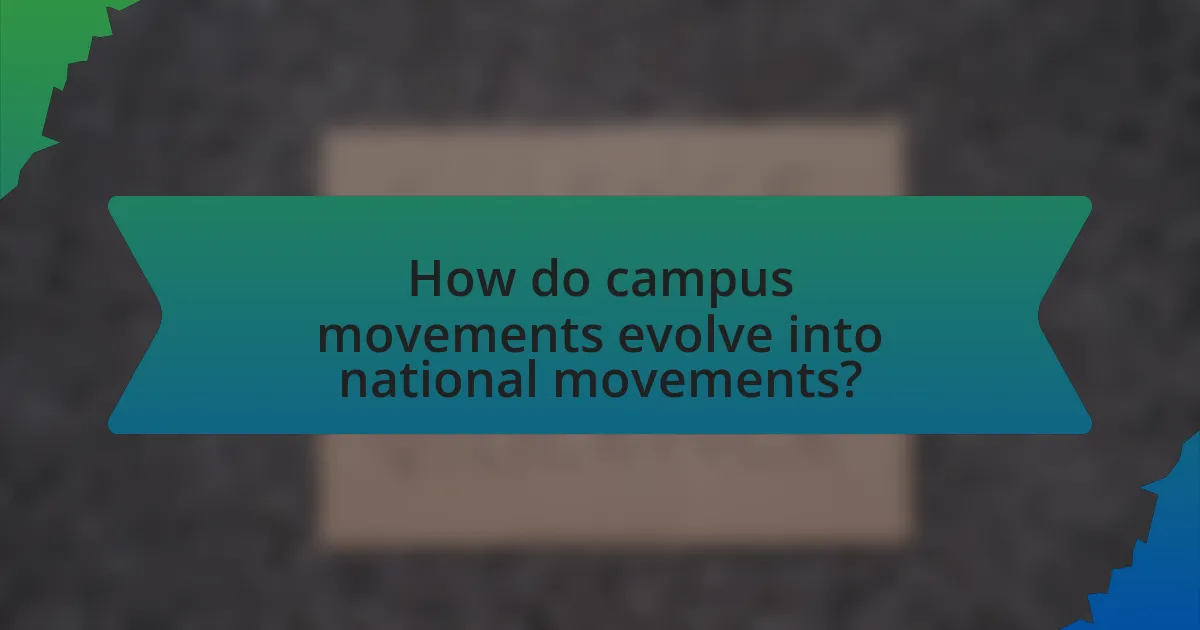
How do campus movements evolve into national movements?
Campus movements evolve into national movements through the amplification of local issues, mobilization of broader public support, and strategic use of media. Initially, campus movements address specific grievances, such as social justice or environmental concerns, which resonate with larger societal issues. As these movements gain traction, they often attract attention from national organizations and activists, who help to broaden the narrative and connect local struggles to national policies. For example, the Civil Rights Movement in the United States saw student-led initiatives on college campuses that highlighted racial injustices, which then inspired nationwide protests and legislative changes. The use of social media further accelerates this process by allowing movements to share their messages widely, engage with diverse audiences, and coordinate actions across different regions, thereby transforming localized efforts into a unified national agenda.
What factors contribute to the transition from campus to national movements?
The transition from campus movements to national movements is primarily influenced by the mobilization of student networks, the amplification of issues through social media, and the alignment of campus agendas with broader societal concerns. Student networks facilitate the sharing of resources and strategies, enabling localized efforts to gain traction on a national scale. Social media serves as a powerful tool for raising awareness and rallying support, as seen in movements like Black Lives Matter, which originated from grassroots activism and expanded into a national dialogue. Additionally, when campus issues resonate with widespread public sentiment, such as climate change or racial justice, they can catalyze larger movements that attract diverse participation and media attention, further solidifying their national impact.
How does collaboration with national organizations enhance movement impact?
Collaboration with national organizations enhances movement impact by providing resources, expertise, and a broader platform for advocacy. National organizations often have established networks, funding opportunities, and strategic knowledge that can amplify the efforts of local movements. For instance, when campus movements partner with national organizations, they can leverage these resources to increase visibility and influence policy changes at higher levels of government. A study by the American Association of University Professors found that coordinated efforts between local and national entities resulted in a 30% increase in successful policy initiatives. This demonstrates that such collaborations not only strengthen the movement’s reach but also enhance its effectiveness in achieving tangible outcomes.
What role do key events play in catalyzing national attention?
Key events serve as pivotal moments that catalyze national attention by highlighting urgent social issues and mobilizing public discourse. For instance, events such as the Kent State shootings in 1970 galvanized anti-war sentiment and led to widespread protests, influencing national policy regarding military engagement. These events often act as catalysts for media coverage, which amplifies their significance and encourages collective action among citizens, thereby shaping public opinion and prompting governmental response. Historical examples demonstrate that key events can shift the trajectory of national conversations, leading to legislative changes and policy reforms.
Why is intersectionality important in campus movements?
Intersectionality is important in campus movements because it recognizes and addresses the diverse and overlapping identities of individuals, which can influence their experiences of oppression and privilege. By incorporating intersectionality, campus movements can create more inclusive strategies that consider factors such as race, gender, sexuality, and socioeconomic status, leading to a more comprehensive understanding of social justice issues. Research by Crenshaw (1989) highlights that failing to consider these intersecting identities can result in the marginalization of certain groups within movements, ultimately weakening their effectiveness and impact on broader national policy changes.
How do diverse voices within campus movements shape national policy agendas?
Diverse voices within campus movements shape national policy agendas by amplifying a range of perspectives that influence public discourse and legislative priorities. These movements often highlight social justice issues, environmental concerns, and educational reforms, which resonate with broader societal values and can mobilize public support. For instance, the Black Lives Matter movement, which gained traction on college campuses, has significantly impacted national conversations around police reform and racial equity, leading to policy proposals at local and federal levels. Additionally, research from the American Council on Education indicates that student activism can lead to increased engagement among policymakers, as they respond to the demands and concerns raised by these diverse voices.
What are the implications of excluding marginalized groups from movements?
Excluding marginalized groups from movements undermines the effectiveness and legitimacy of those movements. When these groups are left out, the movements often fail to address the diverse needs and perspectives essential for comprehensive social change, leading to policies that do not reflect the realities of all affected populations. For instance, the Civil Rights Movement in the United States gained momentum by including voices from various marginalized communities, which helped shape more inclusive legislation, such as the Civil Rights Act of 1964. Conversely, movements that exclude marginalized voices risk perpetuating systemic inequalities and may alienate potential allies, ultimately weakening their impact on national policy change.
How do successful campus movements influence legislative change?
Successful campus movements influence legislative change by mobilizing student activism to advocate for specific policy reforms, thereby creating pressure on lawmakers. For instance, the 2018 March for Our Lives movement, initiated by students from Stoneman Douglas High School, successfully pushed for gun control legislation in several states, demonstrating how organized efforts can lead to tangible policy outcomes. This influence is often amplified through social media campaigns, which increase visibility and public support, compelling legislators to respond to the demands of their constituents.
What are the mechanisms through which policy change occurs?
Policy change occurs through mechanisms such as advocacy, legislative processes, public opinion shifts, and institutional reforms. Advocacy efforts by interest groups and grassroots movements mobilize support and influence decision-makers, while legislative processes involve the drafting, debating, and enacting of laws that reflect new policy priorities. Public opinion shifts can pressure policymakers to adopt changes, as seen in various social movements that have altered perceptions on issues like civil rights and climate change. Institutional reforms, often driven by research and evidence, can lead to changes in organizational policies and practices, further facilitating broader policy shifts. For example, the civil rights movement in the 1960s utilized advocacy and public demonstrations to influence legislation like the Civil Rights Act of 1964, showcasing how these mechanisms can effectively drive policy change.
How can campus movements track their impact on national policy?
Campus movements can track their impact on national policy through systematic data collection and analysis of policy changes, public opinion shifts, and legislative outcomes that correlate with their activism. By utilizing tools such as surveys, social media analytics, and engagement metrics, these movements can assess how their campaigns influence public discourse and policy decisions. For instance, the March for Our Lives movement, advocating for gun control, has been linked to increased legislative proposals and public support for stricter gun laws, evidenced by a 2018 Gallup poll showing a significant rise in support for gun control measures following the movement’s activities.
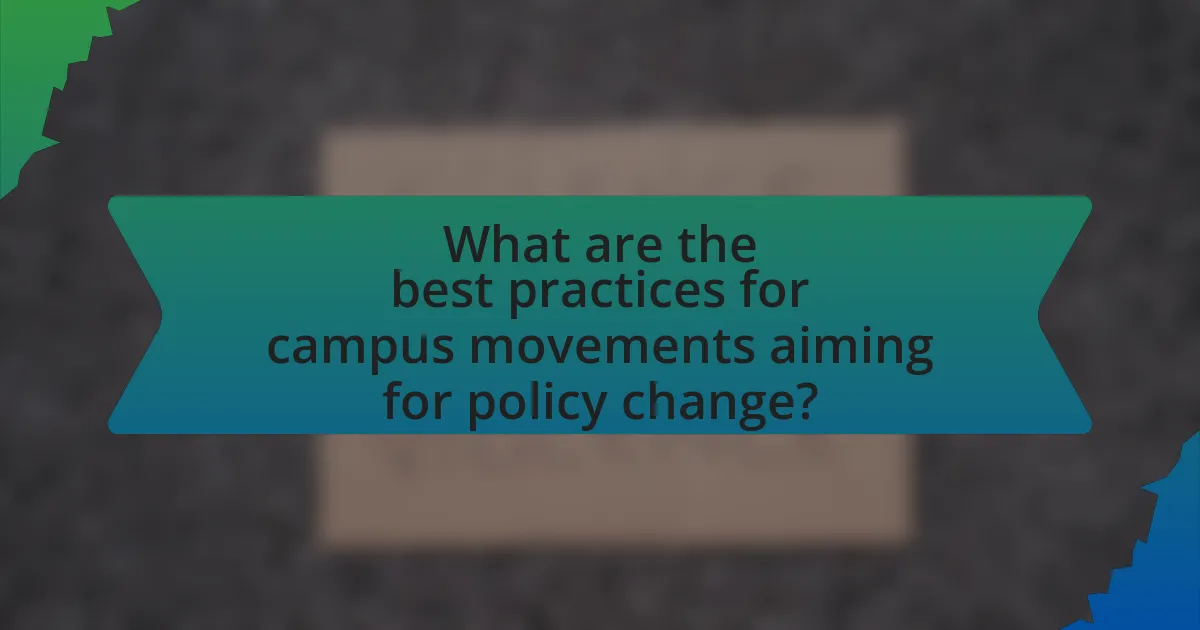
What are the best practices for campus movements aiming for policy change?
The best practices for campus movements aiming for policy change include building a diverse coalition, utilizing clear messaging, engaging in strategic advocacy, and leveraging social media effectively. Building a diverse coalition ensures representation and broad support, which can amplify the movement’s voice and impact. Clear messaging helps articulate the goals and demands of the movement, making it easier for supporters and stakeholders to understand the issues at hand. Strategic advocacy involves identifying key decision-makers and tailoring approaches to influence them, which can include lobbying, organizing events, or participating in public forums. Leveraging social media allows movements to reach a wider audience, mobilize supporters quickly, and create viral campaigns that draw attention to their cause. These practices have been shown to enhance the effectiveness of campus movements, as evidenced by successful initiatives like the March for Our Lives, which effectively combined these strategies to influence gun policy discussions at national levels.
How can campus movements effectively organize and mobilize?
Campus movements can effectively organize and mobilize by utilizing strategic communication, building coalitions, and leveraging social media platforms. Strategic communication ensures that messages resonate with the target audience, while coalition-building fosters unity among diverse groups, enhancing collective strength. For instance, the 2018 March for Our Lives movement, initiated by students after the Parkland shooting, successfully united various organizations and utilized social media to amplify their message, resulting in significant national attention and policy discussions on gun control. This demonstrates that effective organization and mobilization hinge on clear messaging, collaboration, and the strategic use of digital tools to engage a broader audience.
What tools and resources are essential for successful organization?
Effective organization requires tools such as project management software, communication platforms, and data analysis resources. Project management software like Trello or Asana helps teams track tasks and deadlines, ensuring accountability and progress. Communication platforms such as Slack or Microsoft Teams facilitate real-time collaboration, which is crucial for maintaining momentum in movements. Additionally, data analysis resources, including survey tools like Google Forms or statistical software like SPSS, enable organizations to gather and interpret data, informing strategies and demonstrating impact. These tools collectively enhance coordination, streamline processes, and support evidence-based decision-making, which are vital for successful organization in the context of campus movements influencing national policy change.
How can movements build coalitions with other organizations?
Movements can build coalitions with other organizations by identifying shared goals and values, fostering open communication, and establishing mutual trust. For instance, movements focused on social justice can collaborate with environmental organizations to address intersecting issues like climate justice, thereby amplifying their collective impact. Research shows that coalitions formed through shared objectives can enhance resource sharing and mobilization efforts, as seen in the collaboration between the Black Lives Matter movement and various labor unions, which strengthened advocacy for workers’ rights alongside racial equality.
What strategies enhance the visibility of campus movements?
Strategies that enhance the visibility of campus movements include leveraging social media platforms, organizing public events, and forming coalitions with other organizations. Social media platforms like Twitter and Instagram allow movements to reach a wider audience quickly; for instance, the #BlackLivesMatter movement gained significant traction through viral posts and hashtags. Organizing public events, such as rallies and workshops, creates opportunities for direct engagement and media coverage, which can amplify the movement’s message. Additionally, forming coalitions with other campus organizations can consolidate resources and broaden the reach, as seen in various environmental and social justice movements that have successfully collaborated to increase their impact.
How can storytelling be used to connect with broader audiences?
Storytelling can be used to connect with broader audiences by creating relatable narratives that resonate emotionally and culturally. Effective storytelling humanizes complex issues, making them accessible and engaging for diverse groups. For instance, narratives that highlight personal experiences related to social justice can foster empathy and understanding, bridging gaps between different demographics. Research indicates that stories can increase retention of information by up to 65%, demonstrating their power in communication. By utilizing storytelling techniques, movements can amplify their messages, mobilize support, and influence national policy change.
What role does advocacy training play in empowering student leaders?
Advocacy training plays a crucial role in empowering student leaders by equipping them with the skills and knowledge necessary to effectively influence policy and drive social change. This training enhances their ability to articulate issues, mobilize peers, and engage with decision-makers, thereby increasing their impact on campus and beyond. Research indicates that students who undergo advocacy training are more likely to participate in civic activities and lead initiatives that address community concerns, as evidenced by programs like the Campus Election Engagement Project, which reported increased voter turnout and political engagement among trained student leaders.
What lessons can be learned from past campus movements?
Past campus movements demonstrate the power of collective action in influencing national policy change. For instance, the 1960s civil rights movement on college campuses mobilized students to advocate for racial equality, leading to significant legislative changes such as the Civil Rights Act of 1964. Additionally, the anti-Vietnam War protests in the late 1960s showcased how student activism could sway public opinion and ultimately impact government decisions, contributing to the U.S. withdrawal from Vietnam. These examples illustrate that organized student efforts can effectively challenge existing policies and drive societal change.
What common pitfalls should movements avoid?
Movements should avoid fragmentation, which occurs when differing factions within a movement pursue separate agendas, leading to weakened collective action. Fragmentation can dilute the movement’s message and reduce its overall impact, as seen in various social movements where internal divisions hindered progress. For example, the civil rights movement faced challenges when differing strategies emerged among leaders, which sometimes led to public confusion and diminished support. Additionally, movements should steer clear of alienating potential allies by adopting extreme positions that may not resonate with broader audiences, as this can limit their reach and effectiveness.
How can movements adapt to changing political landscapes?
Movements can adapt to changing political landscapes by employing strategic flexibility, which allows them to modify their goals, tactics, and messaging in response to new political realities. For instance, the Civil Rights Movement in the United States shifted its strategies in the 1960s to include legal challenges and grassroots organizing as political support fluctuated, demonstrating adaptability to the evolving political environment. This adaptability is crucial for maintaining relevance and effectiveness, as evidenced by the recent climate justice movements that have adjusted their approaches based on shifting public opinion and political priorities, such as incorporating economic arguments to appeal to a broader audience.
